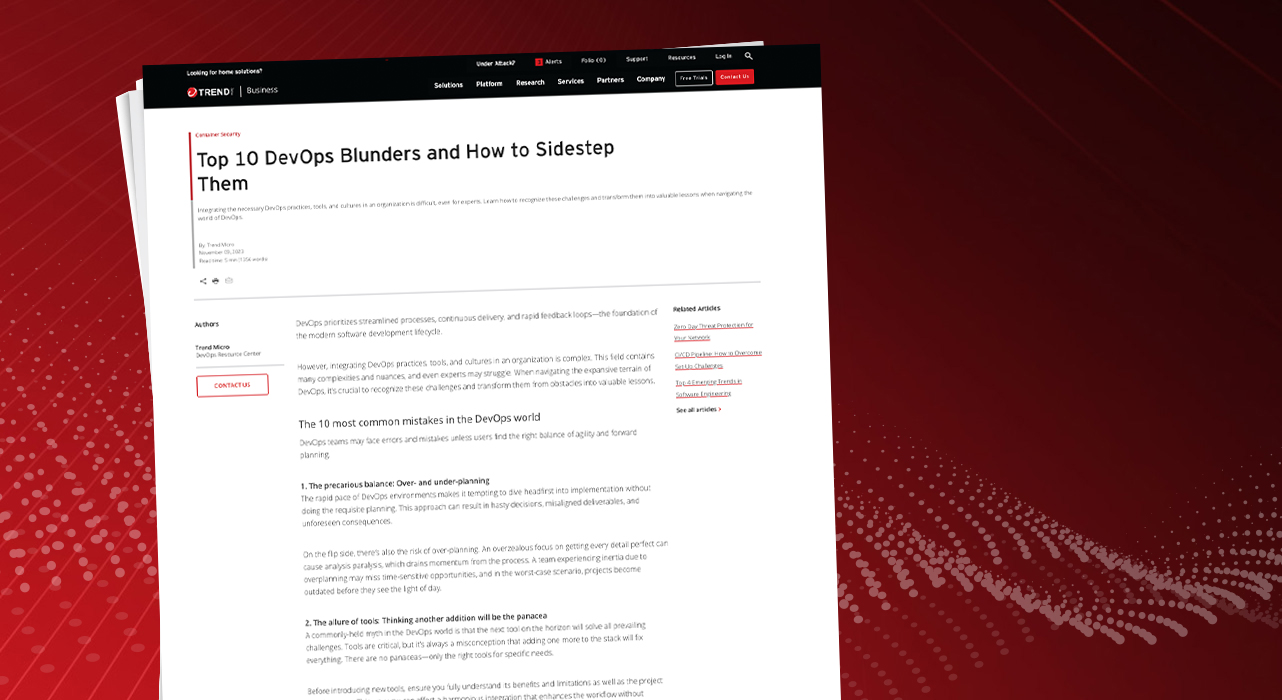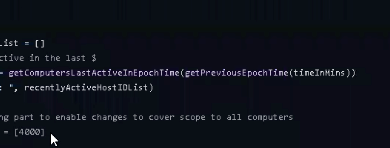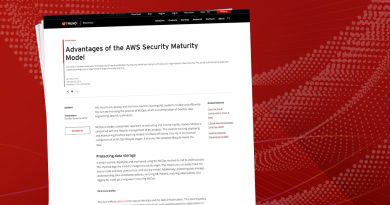Top 10 DevOps Blunders and How to Sidestep Them


DevOps prioritizes streamlined processes, continuous delivery, and rapid feedback loops—the foundation of the modern software development lifecycle.
However, integrating DevOps practices, tools, and cultures in an organization is complex. This field contains many complexities and nuances, and even experts may struggle. When navigating the expansive terrain of DevOps, it’s crucial to recognize these challenges and transform them from obstacles into valuable lessons.
The 10 most common mistakes in the DevOps world
DevOps teams may face errors and mistakes unless users find the right balance of agility and forward planning.
1. The precarious balance: Over- and under-planning
The rapid pace of DevOps environments makes it tempting to dive headfirst into implementation without doing the requisite planning. This approach can result in hasty decisions, misaligned deliverables, and unforeseen consequences.
On the flip side, there’s also the risk of over-planning. An overzealous focus on getting every detail perfect can cause analysis paralysis, which drains momentum from the process. A team experiencing inertia due to overplanning may miss time-sensitive opportunities, and in the worst-case scenario, projects become outdated before they see the light of day.
2. The allure of tools: Thinking another addition will be the panacea
A commonly-held myth in the DevOps world is that the next tool on the horizon will solve all prevailing challenges. Tools are critical, but it’s always a misconception that adding one more to the stack will fix everything. There are no panaceas—only the right tools for specific needs.
Before introducing new tools, ensure you fully understand its benefits and limitations as well as the project requirements. This way, you can affect a harmonious integration that enhances the workflow without complicating it.
3. Letting perfect be the enemy of good
Striving for perfection is a commendable trait, but when it comes to DevOps, it can sometimes cause more harm than good. Obsessing over the perfect solution can result in missed deadlines and never-ending development cycles. Instead of aiming for flawless execution from the outset, professionals should embrace the philosophy of iterative improvements.
The minimum viable product (MVP) approach aims to launch a product with just enough features to make it viable, followed by continuous refinement based on feedback. This approach ensures progress and adaptability, positioning teams to respond more effectively to emerging needs and challenges.
4. Security oversights
Security is a cornerstone of DevOps. A simple oversight can have catastrophic outcomes unless you safeguard machines and networks. The consequences range from data breaches compromising sensitive information to system vulnerabilities that cybercriminals can ruthlessly exploit.
Neglecting security jeopardizes your data and tarnishes its reputation, leading clients and stakeholders to lose confidence in your company. With the rapid evolution of cyber threats today, staying on top of data security is imperative for DevOps professionals.
5. Not understanding the problem
Clear communication is at the heart of effective DevOps operations. When professionals dive into tasks without first asking clarifying questions, the results are often misguided solutions that fail to address the root problem. Such oversights can lead to wasted time and resources—sometimes even exacerbating the issue they should address.
Understanding the nuances of stakeholder needs is imperative. It’s not just about solving a problem but aligning the solution with the desired outcome. The key to DevOps success is a culture of open communication where individuals consistently seek clarity from their colleagues.
6. Bypassing code reviews and quality gates
While pursuing agility, some DevOps teams might sidestep code reviews and quality gates. However, this practice can lead to the integration of unchecked code, possibly introducing errors, vulnerabilities, or inefficiencies into the system. Code reviews serve as a critical checkpoint, ensuring code functions as intended and adheres to established standards, promoting consistency and maintainability across the codebase.
Furthermore, quality gates—which automatically assess code against predefined criteria—are safeguards. They ensure that only code meeting specific quality benchmarks progresses through the pipeline. Neglecting these checks may offer short-term speed gains, but only by risking long-term system stability and overall software quality. Honoring code reviews and quality gates affirms your commitment to excellence despite tight deadlines and mounting pressures.
7. Logging blind spots
Logs are the eyes and ears of the DevOps team. DevOps teams must log all information as they monitor, debug, and audit their processes.
However, logging has a host of common pitfalls. Some teams flood their logs with inconsequential details, burying critical events under heaps of trivial information. Others might neglect to log crucial events altogether or employ inconsistent log formats that reduce clarity. These inefficient logging practices can camouflage issues, leading to missed anomalies and extended troubleshooting times.
DevOps teams should adhere to best practices by implementing structured and meaningful logging methods and balancing comprehensiveness and concision. The most useful logs deliver insight without overwhelming the system or the team.
8. Ignoring the artifact lifecycle: Not promoting artifacts through environments
Promoting artifacts, such as software builds, through a structured sequence—from development to testing, staging, and finally production—is a linchpin of the DevOps process. Methodical progression ensures that each build is thoroughly vetted, optimized, and ready for deployment. Bypassing any of these crucial steps or introducing inconsistencies can jeopardize the reliability and stability of the final product. Shortcuts in the artifact lifecycle may save time in the short run. However, they can eventually lead to undetected issues, potential system failures, and an erosion of trust in the deployment pipeline.
When deadlines are bearing down, it’s tempting to expedite deployments any way you can. However, every environment in the artifact lifecycle has a purpose. Development environments allow for the creation and initial testing of new code. Testing environments ensure functionality, stability, and performance. Staging mirrors the production environment, a final checkpoint before public release. Skipping or mishandling any of these stages exposes the product to potential flaws and robs the team of valuable feedback loops.
Properly promoting artifacts is key to quality assurance, ensuring you meticulously scrutinize every change and meet the highest standards.
9. Not keeping code versions
Version control in code development is like saving waypoints in a journey, marking critical points that users can find and reference later. This is crucial for several reasons.
Firstly, version control provides traceability, allowing teams to track changes over time and understand the evolution of the codebase. Collaboration is smoother as team members can work on different features simultaneously—without stepping on each other’s toes—merging their contributions without conflict later. If a new feature introduces issues or a critical bug emerges, versioning means you can roll back to a stable state.
However, neglecting proper versioning can lead to a multitude of challenges. Without a clear record of changes, merging disparate code branches can become a nightmare. Conflicts that arise may prove tedious or impossible to resolve.
A lack of consistent versioning can result in more than just technical issues—it can cause lost features or reintroduce previously addressed bugs. Consistent versioning is best practice because it’s essential to maintaining integrity and efficiency.
10. Resistance to change: Sticking to legacy systems
Clinging to legacy systems can be a significant impediment. While legacy systems may be deeply entrenched and familiar, they often lack the agility required for modern DevOps practices. Persisting with these systems can lead to compatibility issues, increased security vulnerabilities, and drain resources as teams grapple with maintaining outdated infrastructure.
More broadly, a steadfast attachment to legacy systems often indicates organizational resistance to innovation. Teams that prefer traditional methods over transformation may risk stagnating. Embracing the DevOps ethos means recognizing when the comforts of the past hinder growth and sustained success in the future.
Learning from DevOps missteps
Even the most seasoned DevOps professionals can run into pitfalls that profoundly affect the development lifecycle.
However, these challenges also present invaluable learning opportunities. By recognizing and understanding these mistakes, individuals and teams can proactively avoid them and help foster an environment of growth.
As you navigate DevOps, remember that continuous learning and iterative improvement aren’t just concepts but cornerstones of excellence. Embrace every misstep as a step forward and let each challenge shape a more resilient, knowledgeable, and effective DevOps team.
Read More HERE



